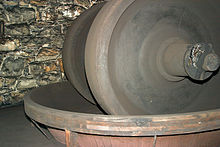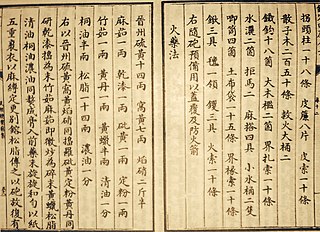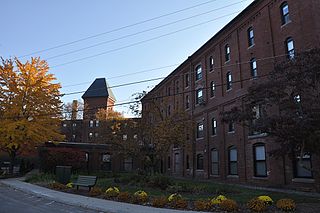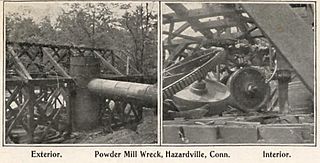

A powder mill was a mill where gunpowder is made [1] from sulfur, saltpeter and charcoal.


A powder mill was a mill where gunpowder is made [1] from sulfur, saltpeter and charcoal.
Crude grinding and mixing operations such as the Frankford Powder-Mill of Philadelphia were a cottage industry until the industrial revolution brought improved product quality through the following procedures:

Gunpowder is very easily ignited by static electricity or lightning strikes, and most powder mills experienced occasional accidental explosions. Powder mill explosions typically destroyed an entire building and killed those working in the vicinity of the building. Explosions might throw flaming debris which could ignite other buildings. Successful mills were typically built as an arrangement of separate buildings to minimize the loss from any single building explosion. Buildings were separated by enough distance to minimize the risk of being damaged by an explosion in an adjacent building. Buildings were usually built of stone with one weak wooden wall and roof to direct the force and debris from an accidental explosion toward a river or an open field. [2]
Powder mills were originally powered by windmills, water mills or horse mills. Despite later availability of steam engines, the older power sources did not require a fire to generate steam, and avoided the possibility of sparks which might ignite the gunpowder. Some 20th-century powder mills used electric power. Before the availability of safe electrical power, some of the most successful mills were built along rivers where water could be distributed through a power canal to individual buildings and intermediate products could be floated from one building to the next. The power canal offered a supply of firefighting water, and the adjacent river was a relatively safe direction to focus explosion debris. Where water transport was impractical, intermediate products were often transported in wagons pulled by draft animals. The wagons were often built entirely of wood held together with wooden pegs, and draft animals were usually unshod to avoid sparks from steel shoes or nails. [2]
The 1810 census reported 208 powder mills in the United States. [2] In 1802, the DuPont family started their industrial enterprises in the United States by building the Eleutherian Mills on the Brandywine Creek in Delaware. [4] Four mills were manufacturing 69 percent of United States gunpowder when gunpowder production peaked during the American Civil War. They were the DuPont mill, the Hazard Powder Company of Hazardville, Connecticut, the Oriental Powder Company of Windham, Maine, and the Laflin Powder Company of Newburgh, New York. [5] The Confederate Powderworks of Augusta, Georgia produced 6,000 tonnes of gunpowder from 1862 to 1865, but was dismantled after the war. [6] The Laflin company merged into the Laflin & Rand Powder Company after the war, and with the other three large northern mills formed the United States Gunpowder Trade Association in 1872 including the American Powder Mills of Maynard, Massachusetts, the Austin Powder Company of Glenwillow, Ohio, and the Miami Powder Company of Goes Station, Ohio. [7] Most smaller mills were unable to compete with this trade association, popularly known as the powder trust; although regionally important mills including the California Powder Works of Santa Cruz, California, the Equitable Powder Company of East Alton, Illinois, [8] and the Great Western Powder Works of Kings Mills, Ohio [9] successfully transitioned to manufacture of smokeless powder cartridges. As smokeless powder and high explosives replaced gunpowder for most purposes, DuPont became the major manufacturer of United States gunpowder until discontinuing production in 1971. Subsequent production for use in pyrotechnics and antique firearms has been undertaken by smaller firms whose operations are often ended by the persistent hazard of accidental explosions. [10]
Notable European mills include:

Gunpowder, also commonly known as black powder to distinguish it from modern smokeless powder, is the earliest known chemical explosive. It consists of a mixture of sulfur, carbon and potassium nitrate (saltpeter). The sulfur and carbon act as fuels while the saltpeter is an oxidizer. Gunpowder has been widely used as a propellant in firearms, artillery, rocketry, and pyrotechnics, including use as a blasting agent for explosives in quarrying, mining, and road building.

Windham is a town in Cumberland County, Maine, United States. The population was 18,434 at the 2020 census. It includes the villages of South Windham and North Windham. It is part of the Portland–South Portland–Biddeford, Maine Metropolitan Statistical Area.

The Hagley Museum and Library is a nonprofit educational institution in unincorporated New Castle County, Delaware, near Wilmington. Covering more than 235 acres (95 ha) along the banks of the Brandywine Creek, the museum and grounds include the first du Pont family home and garden in the United States, the powder yards, and a 19th-century machine shop. On the hillside below the mansion lies a Renaissance-revival garden, with terraces and statuary, created in the 1920s by Louise Evalina du Pont Crowninshield (1877–1958).

Smokeless powder is a type of propellant used in firearms and artillery that produces less smoke and less fouling when fired compared to gunpowder. The combustion products are mainly gaseous, compared to around 55% solid products for black powder. In addition, smokeless powder does not leave the thick, heavy fouling of hygroscopic material associated with black powder that causes rusting of the barrel. Despite its name, smokeless powder is not completely free of smoke; while there may be little noticeable smoke from small-arms ammunition, smoke from artillery fire can be substantial.

The Peters Cartridge Company was a company located along the Little Miami River in Kings Mills, Ohio, which specialized in gunpowder and ammunition production. Founded in 1887 by Gershom Moore Peters, the company supplied military ammunition to various countries during both world wars. Following its demise in 1944, the site was repurposed by Columbia Records and later Seagram, before being abandoned in 1968 and falling into disrepair. Its historic buildings, built in 1916, were added to the National Register of Historic Places in 1985. A brewery and apartment complex themed to the defunct company was constructed on site in 2020, in which many structures were restored and the company's history was placed on display for guests.

Matthew Laflin was an American manufacturer of gunpowder, businessman, philanthropist, and an early pioneer of Chicago, Illinois.
Hercules, Inc. was a chemical and munitions manufacturing company based in Wilmington, Delaware, United States, incorporated in 1912 as the Hercules Powder Company following the breakup of the DuPont explosives monopoly by the U.S. Circuit Court in 1911. Hercules Powder Company became Hercules, Inc. in 1966, operating under this name until 2008, when it was merged into Ashland Inc.

The Ballincollig Royal Gunpowder Mills was one of three Royal gunpowder mills that manufactured gunpowder for the British Government. Located in Ballincollig, Cork city, Ireland, largely in what is now the Ballincollig Regional Park, the powder mills were originally opened in 1794 as a private enterprise, before being taken over by the British Government during the Napoleonic Wars.

The Wujing Zongyao, sometimes rendered in English as the Complete Essentials for the Military Classics, is a Chinese military compendium written from around 1040 to 1044.

From 1802 to 1921, Eleutherian Mills was a gunpowder mill site used for the manufacture of explosives founded by Eleuthère Irénée du Pont, which grew into the DuPont company. The name also refers to the house on the hill above the mills, which was the first du Pont family home in America. In 1957 the site became an outdoor museum when the Hagley Museum and Library was founded. The site was declared a National Historic Landmark in 1966.
The Frankford Powder-Mill is a historic gunpowder factory in the Frankford neighborhood of Philadelphia, Pennsylvania.

The Wamesit Canal-Whipple Mill Industrial Complex is a historic mill and canal at 576 Lawrence Street in Lowell, Massachusetts. This industrial area of Lowell, located on the Concord River, underwent a major expansion from a more modest millworks in the mid-19th century by Oliver Whipple, a manufacturer of gunpowder.

The Hazard Powder Company is a former American manufacturer of gunpowder and explosives. It was located in Hazardville within the town of Enfield, Connecticut.

California Powder Works was the first American explosive powder manufacturing company west of the Rocky Mountains. When the outbreak of the Civil War cut off supplies of gunpowder to California's mining and road-building industries, a local manufacturer was needed. Originally located near Santa Cruz, California, the company was incorporated in 1861 and began manufacturing gunpowder in May 1864. For 50 years, it was a major employer in the county, employing between 150 and 275 men. The powder works was located on a flat adjacent to the San Lorenzo River, three miles upstream of Santa Cruz.
Oriental Powder Company was a gunpowder manufacturer with mills located on the Presumpscot River in Gorham and Windham, Maine. The company was one of the four largest suppliers to Union forces through the American Civil War.

Laflin & Rand Powder Company was a gunpowder and early smokeless powder manufacturer notable for producing the smokeless powder used by United States Army infantry rifles from 1896 to 1908, which included the period of development of the M1903 Springfield rifle and .30-06 Springfield cartridge.
The Tiangong Kaiwu (天工開物), or The Exploitation of the Works of Nature was a Chinese encyclopedia compiled by Song Yingxing. It was published in May 1637 with funding provided by Song's patron Tu Shaokui. The Tiangong Kaiwu is an encyclopedia covering a wide range of technical issues, including the use of various gunpowder weapons. Copies of the book were very scarce in China during the Qing dynasty (1644–1911), but original copies of the book were preserved in Japan.
American Powder Mills (1883–1929) was a Massachusetts gunpowder manufacturing complex on the Assabet River. It expanded to include forty buildings along both sides of the river in the towns of Acton, Concord, Maynard, and Sudbury. Press mills, kernelling mills, glazing mills, and storehouses were dispersed over four-hundred acres to minimize damage during explosions. A narrow gauge railway transferred raw materials and products between the buildings.
Miami Powder Company operated a gunpowder manufacturing complex on the Little Miami River at Goes Station, Ohio from 1855 to 1925. Willows growing along the banks of the Little Miami River provided the charcoal required for gunpowder. Production was approximately 75 percent rifle powder and 25 percent blasting powder.

The Poudrerie nationale de Vonges is a French powder mill established in 1691 in Vonges, Côte-d'Or. It manufactured explosives for use in quarries, mines and fireworks. During World War I (1914–18) it manufactured munitions. It expanded after the war, producing explosives for civil use. During World War II (1939–45) production was scaled back drastically, but expanded again after the war. The powder mill was fully privatized in 2008.